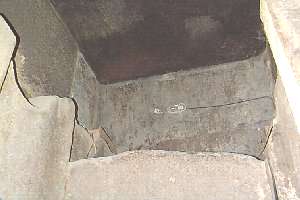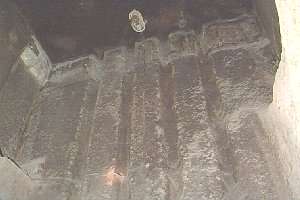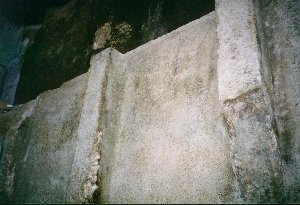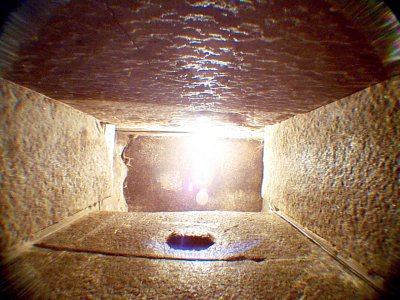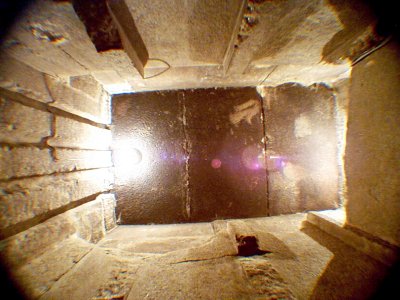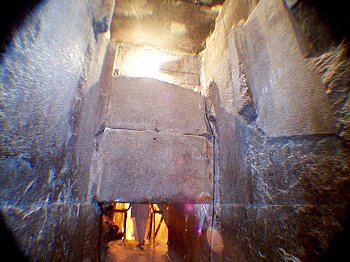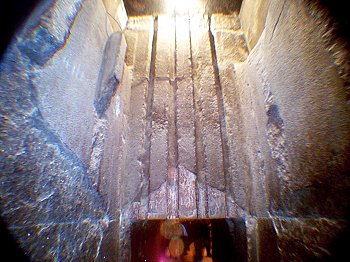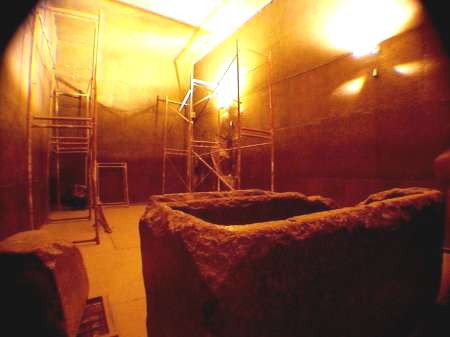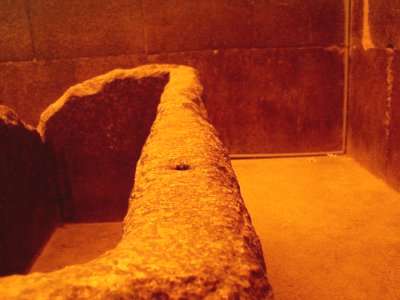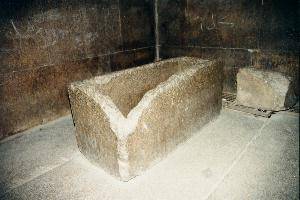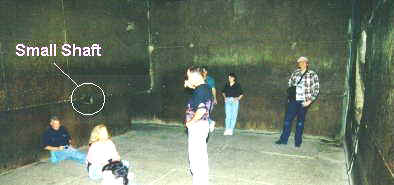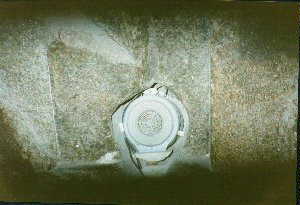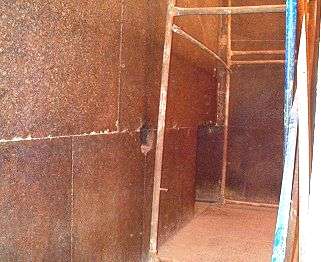|
The Grand Gallery As we follow the ascending passageway we come to the Grand Gallery, a
grand corbelled hall: This first view was taken looking up toward the so-called King's or burial Chamber. At the base, between the ramps lies the passageway to the middle chamber. The second view was taken looking down from the end of the sloping gallery back toward the bottom. NEW:
The passageway to the antechamber and the main chamber is straight ahead at the end of the ramp, in this photo, under the ladder. The Antechamber Ascending up the walkway to the upper chamber, you first enter an antechamber lined with large grooves that once housed the large granite portcullis blocks that were lowered to seal off the main chamber:
The antechamber is subdivided into 2 sections: The first picture shows the smaller north subdivision looking straight up. The second view shows the south subdivision, also looking straight upward. In this view, you can see both the grooves for the portcullis blocks (top and bottom of view) and the smaller grooves (left) for the ropes to lower the blocks. The following two pictures of the south wall of the antechamber were
taken with a wide angle lens, the chamber is much narrower than it appears in these
photos.
The Main Chamber Looking west inside the main chamber, now known as the King's Chamber, is the original coffer which was put into place before the ceiling was built onto this room. Over the centuries the coffer has been damaged as can be seen by the broken corner. Modern day lighting has been installed as well as surveillance equipment to monitor the chamber. The walls are conspicuously bare and uninscribed. Only in later pyramids would hieroglyphs adorn the walls of the inner chambers.
From the west wall looking east in this picture you can see scaffolding
that is used during periods of restoration to clean and restore the walls of the chamber.
The passageway leading into and out of the chamber is on the left at the east end of the
north wall.
On the west edge of the coffer are the holes which were used to attach
the lid to the coffer. The lid is long gone and no traces of it have been found in modern
times. Also note the very small shafts on the north and south walls which lead out onto the surface of the pyramid, sometimes called the "air shafts". The south air shaft has been used to install a ventilation system to recirculate the air of the chamber which helps to alleviate moisture build-up and avoid stagnant and stale air accumulation. A new ventilation system has been installed since this photo was taken, during the most recent 1998 restoration. The other air shaft on the north wall remains open. The left view shows the chamber looking east without the scaffolding. You can see the entrance on the left corner.
The following pictures, with the scaffolding, show the north air shaft and the entrance more clearly:
Explore the Subterranean Chamber Special thanks to Larry Orcutt BACK to Great Pyramid Part 1  RETURN TO Guardian's Egypt - Main Gate RETURN TO Guardian's Giza - Main Gate Guardian's CyberJourney To Egypt |


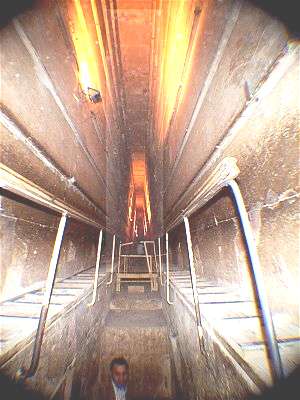
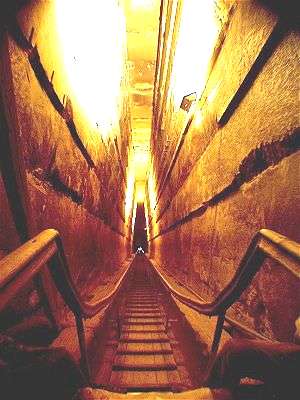
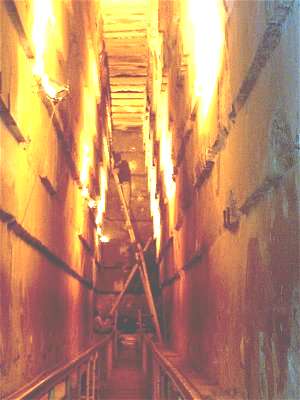 At the south end of the Grand Gallery lies the passageway
that leads to the antechamber and main chamber, the so-called King's or Burial chamber.
The ladder in this picture leads up to a set of chambers known as the "relieving
chambers". In a later installment of the CyberJourney new detailed pictures of the
inside of these chambers will be added. These chambers appear not to have been meant to be
entered, and it is speculated that they were included to relieve the pressure of the
massive tonnage of rock above the main burial chamber. In modern times, these chambers
were discovered by the crude act of using dynamite to create an intrusive passageway. The
chambers are only a few feet high each. Evidence within the chambers supports that they
were never meant to store anything or be entered. This evidence consists of the workman's
red markings or graffiti that were painted on the building stones, usually just after they
were cut, to inventory the stones and to help determine the final destination in the
pyramid of each stone. After stones were laid and the pyramid was finished any of these
markings that might be on visible surfaces would be scraped away clean. The presence of
these unremoved markings in these chambers, with no other such markings found anywhere in
the pyramid, suggests that these surfaces were never intended to been seen. Some of these
markings even occur under where one rock rests upon another proving that they had to be
painted before the stones were laid.
At the south end of the Grand Gallery lies the passageway
that leads to the antechamber and main chamber, the so-called King's or Burial chamber.
The ladder in this picture leads up to a set of chambers known as the "relieving
chambers". In a later installment of the CyberJourney new detailed pictures of the
inside of these chambers will be added. These chambers appear not to have been meant to be
entered, and it is speculated that they were included to relieve the pressure of the
massive tonnage of rock above the main burial chamber. In modern times, these chambers
were discovered by the crude act of using dynamite to create an intrusive passageway. The
chambers are only a few feet high each. Evidence within the chambers supports that they
were never meant to store anything or be entered. This evidence consists of the workman's
red markings or graffiti that were painted on the building stones, usually just after they
were cut, to inventory the stones and to help determine the final destination in the
pyramid of each stone. After stones were laid and the pyramid was finished any of these
markings that might be on visible surfaces would be scraped away clean. The presence of
these unremoved markings in these chambers, with no other such markings found anywhere in
the pyramid, suggests that these surfaces were never intended to been seen. Some of these
markings even occur under where one rock rests upon another proving that they had to be
painted before the stones were laid.